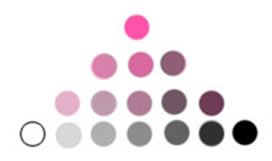A page from the "Causes of Color" exhibit...
Mixing Colored Inks and Paints

All color printing processes use something called the subtractive mixing of colors to take out portions of white light to produce the colors we see. You can illustrate this subtractive process while having some fun mixing different colored inks or tempera paints.
Materials
- Tempera paints or printer inks in cyan, magenta, and yellow (Note: soap and water will clean up tempera paint, but you need isopropyl alcohol to clean up spilled ink.)
- White poster board, paper plates, or copy paper on top of newspaper
- Plastic spoons, brushes, or popsicle sticks
How To Do It
- Put an equal amount of cyan, magenta, and yellow paint equidistant from each other in a circle on a white poster board, paper plate, or piece of copy paper.
- Use a clean brush, spoon, or popsicle stick to mix a little magenta and yellow paint. You might see a red color.
- Use another clean implement to mix cyan and yellow paint. You might see a yellow color.
- Use another clean implement to mix magenta and cyan paint. You might see a blue color.
- In the middle of the white surface, mix cyan, magenta, and yellow.
- In a clean place on the paper, try mixing red, blue, and green.
How It Works
The oldest of all color circles is based on subtractive color and uses cyan, magenta, and yellow as the primary colors. Often blue, red, and yellow are used as the primaries, instead of cyan, magenta and yellow. This variation is historical in origin, and based on the availability of pigments. Read more about color theory.
The arrangement of the colors around a color wheel is often thought to be in correspondence with the wavelengths of light, as postulated with the original color circle of Sir Isaac Newton. He was the first to use the word “spectrum” to represent the colors of white light as it passes through a prism. In normal human vision, wavelengths of between 400 nm and 700 nm are represented in the circle, where reds are the longer wavelength and blues and violets are the shorter wavelengths.
Subtractive color starts with an object that reflects light and uses colors to subtract parts of the white light illuminating the object to produce other colors. Color paintings, color photography, and all color printing processes use the subtractive process to produce color.
The printing process uses colored inks that subtract portions of the white light striking the image on the paper. Printing inks are transparent; the transparency allows light to pass through to and reflect off of the paper. It is the paper that reflects any unabsorbed light back to your eye. Each process printing ink (cyan, magenta, and yellow), absorbs or subtracts certain portions of white light and reflects others.
| Ink Color | Absorbs | Reflects | Appears |
|---|---|---|---|
| Cyan | Red light | Green & Blue light | Cyan |
| Magenta | Green light | Red & Blue light | Magenta |
| Yellow | Blue light | Red & Green light | Yellow |
| M + Y | Green & Blue light | Red light | Red |
| C + Y | Red & Blue light | Green light | Green |
| C + M | Red & Green light | Blue light | Blue |
Adapted with permission from Understanding Color.

Play with white and black paint to produce tint triangles.
Variations
It is an interesting adventure to repeat the same activity, making a circle of colors using paints: red, blue, and yellow. Mixing these three colors will yield three colors: green, orange, and purple.
You can try a different experiment with rectangles of color. Start at the three Xs in the picture using black, blue, and orange to reproduce the artist’s rectangles. Can you experiment with black and two other colors to produce your own rectangles of color?
You can also explore color variations with this helpful guide to artists from Argentine painter Eolo Pons.
And, then explore different “surrounds”, which is a study in contrasting colors.



